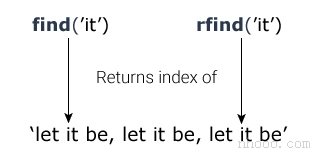编辑这个页面须要登录或更高权限!
- 您刚才的请求只有这个用户组的用户才能使用:自动确认用户
- 如果您还没有登录请登录后重试。编程那点事是一个开放式网站,修改本站大部分内容仅须要花10秒钟时间创建一个账户。 如果您已经登录,本页面可能是受保护的内容。如果您认为有修改的必要,请联系本站管理人员。
- 该页面已被锁定以防止编辑。
Python 字符串 find() 使用方法及示例
find()方法返回子字符串首次出现的索引值(如果找到)。如果找不到,则返回-1。
find()方法的语法为:
str.find(sub[, start[, end]] )
find()参数
find()方法最多使用三个参数:
sub- 它是在str字符串中要搜索的子字符串。
start和end (可选)-在其中搜索子字符串str[start:end]
find()返回值
find()方法返回一个整数值。
如果字符串中存在子字符串,则返回该子字符串首次出现的索引。
如果字符串中不存在子字符串,则返回-1。

示例1:无开始和结束参数的find()
quote = 'Let it be, let it be, let it be'
result = quote.find('let it')
print("子字符串 'let it':", result)
result = quote.find('small')
print("子字符串 'small ':", result)
# 如何使用find()
if (quote.find('be,') != -1):
print("包含字符串 'be,'")
else:
print("未包含字符串")运行该程序时,输出为:
子字符串 'let it': 11 子字符串 'small ': -1 包含字符串 'be,'
示例2:带有开始和结束参数的find()
quote = 'Do small things with great love'
# 搜索子字符串 'hings with great love'
print(quote.find('small things', 10))
# 搜索子字符串 ' small things with great love'
print(quote.find('small things', 2))
# 搜索子字符串 'hings with great lov'
print(quote.find('o small ', 10, -1))
# 搜索子字符串 'll things with'
print(quote.find('things ', 6, 20))运行该程序时,输出为:
-1 3 -1 9
- Copyright © 2003-2013 菜鸟教程。
- 版权与免责声明
